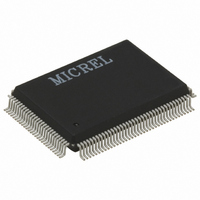KS8995MAL Micrel Inc, KS8995MAL Datasheet - Page 29

KS8995MAL
Manufacturer Part Number
KS8995MAL
Description
IC SWITCH 10/100 5PORT 128PQFP
Manufacturer
Micrel Inc
Datasheet
1.KSZ8995MA.pdf
(73 pages)
Specifications of KS8995MAL
Applications
*
Mounting Type
Surface Mount
Package / Case
128-MQFP, 128-PQFP
For Use With
576-1017 - BOARD EVAL EXPERIMENT KS8995M
Lead Free Status / RoHS Status
Contains lead / RoHS non-compliant
Available stocks
Company
Part Number
Manufacturer
Quantity
Price
Learning state: only packets to and from the processor are forwarded. Learning is enabled.
Port setting: “transmit enable = 0, receive enable = 0, learning disable = 0.”
Software action: The processor should program the static MAC table with the entries that it needs to receive (e.g., BPDU
packets). The “overriding” bit should be set so that the switch will forward those specific packets to the processor. The processor
may send packets to the port(s) in this state, see “Special Tagging Mode” section for details. Address learning is enabled on
the port in this state.
Forwarding state: packets are forwarded and received normally. Learning is enabled.
Port setting: “transmit enable = 1, receive enable = 1, learning disable = 0.”
Software action: The processor should program the static MAC table with the entries that it needs to receive (e.g., BPDU
packets). The “overriding” bit should be set so that the switch will forward those specific packets to the processor. The processor
may send packets to the port(s) in this state, see “Special Tagging Mode” section for details. Address learning is enabled on
the port in this state.
Special Tagging Mode
The special tagging mode is designed for spanning tree protocol IGMP snooping and is flexible for use in other applications.
The special tagging mode, similar to 802.1q, requires software to change network drivers to insert/modify/strip/interpret the
special tag. This mode is enabled by setting both Register 11 bit 0 and Register 80 bit 2.
The STPID will only be seen and used on the port 5 interface, which should be connected to a processor. Packets from the
processor to the switch should be tagged with STPID and the port mask defined as below:
“0000” normal tag, will use the KS8995MA internal look-up result. Normal packets should use this setting. If packets from the
processors do not have a tag, the KS8995MA will treat them as normal packets and an internal look-up will be performed.
The KS8995MA uses a non-zero “port mask” to bypass the look-up result and override any port setting, regardless of port states
(blocking, disable, listening, learning). Table 5 shows the egress rules when dealing with STPID.
May 2005
KS8995MA
802.1q Tag Format
TPID (tag protocol identifier, 0x8100) + TCI
“0001” packet to port 1 only
“0010” packet to port 2 only
“0100” packet to port 3 only
“1000” packet to port 4 only
“0011” packet broadcast to port 1 and port 2.
.....
“1111” packet broadcast to port 1, 2, 3 and 4.
Table 4. Special Tagging Mode Format
Special Tag Format
STPID (special tag identifier, 0x8100) + TCI 0x810 + 4 bit for “port mask”) + TCI
29
M9999-051305
Micrel, Inc.












